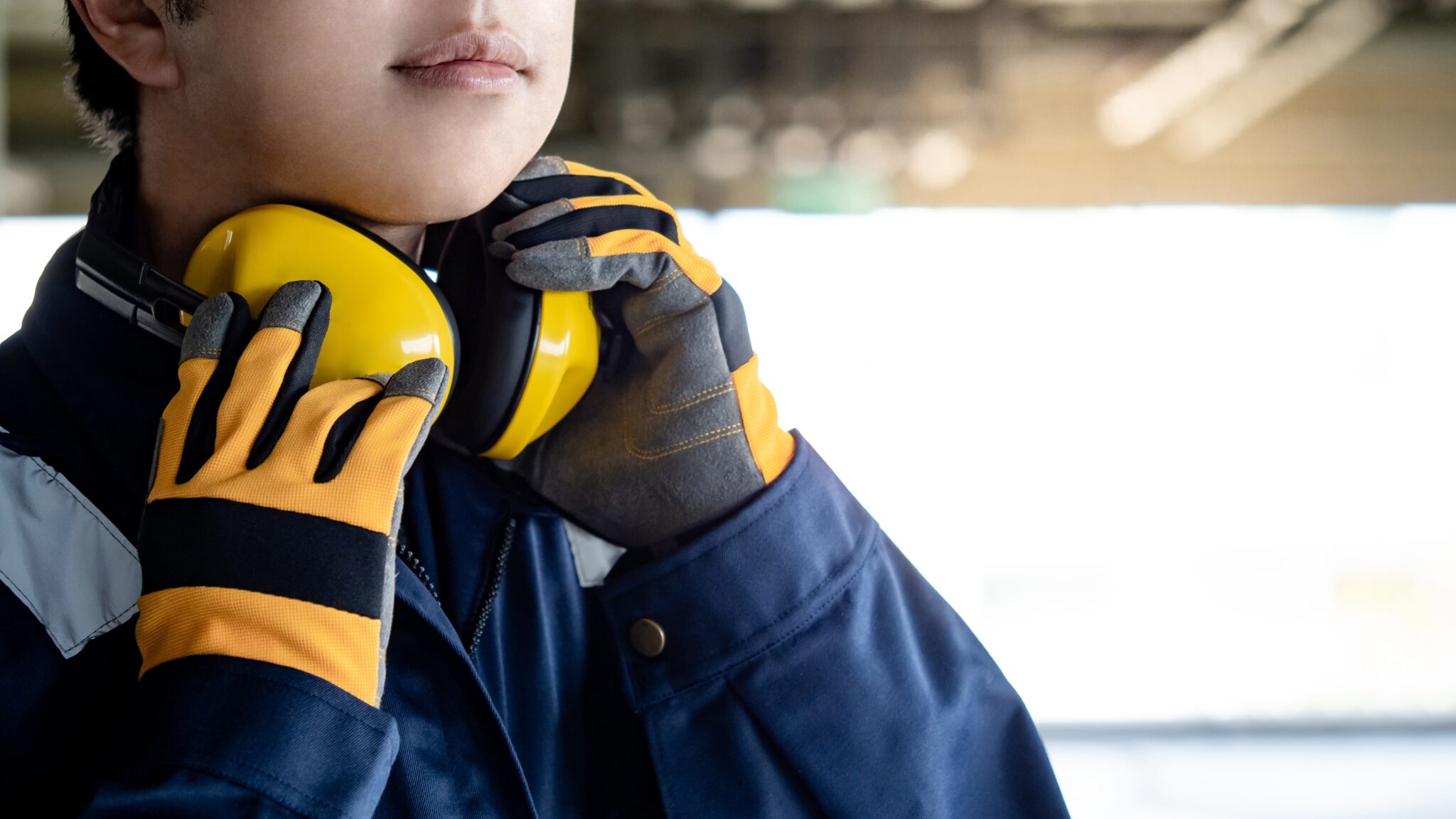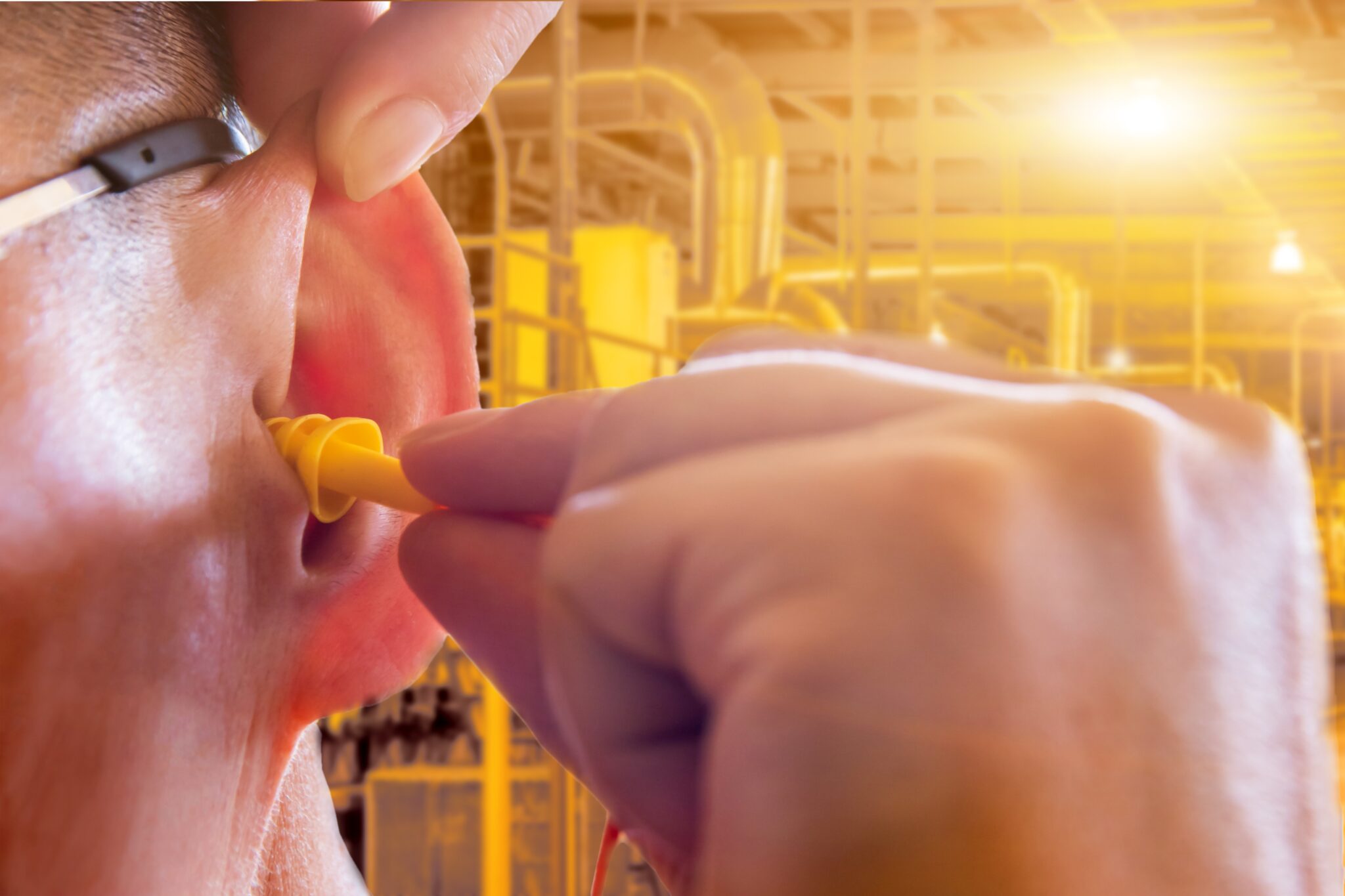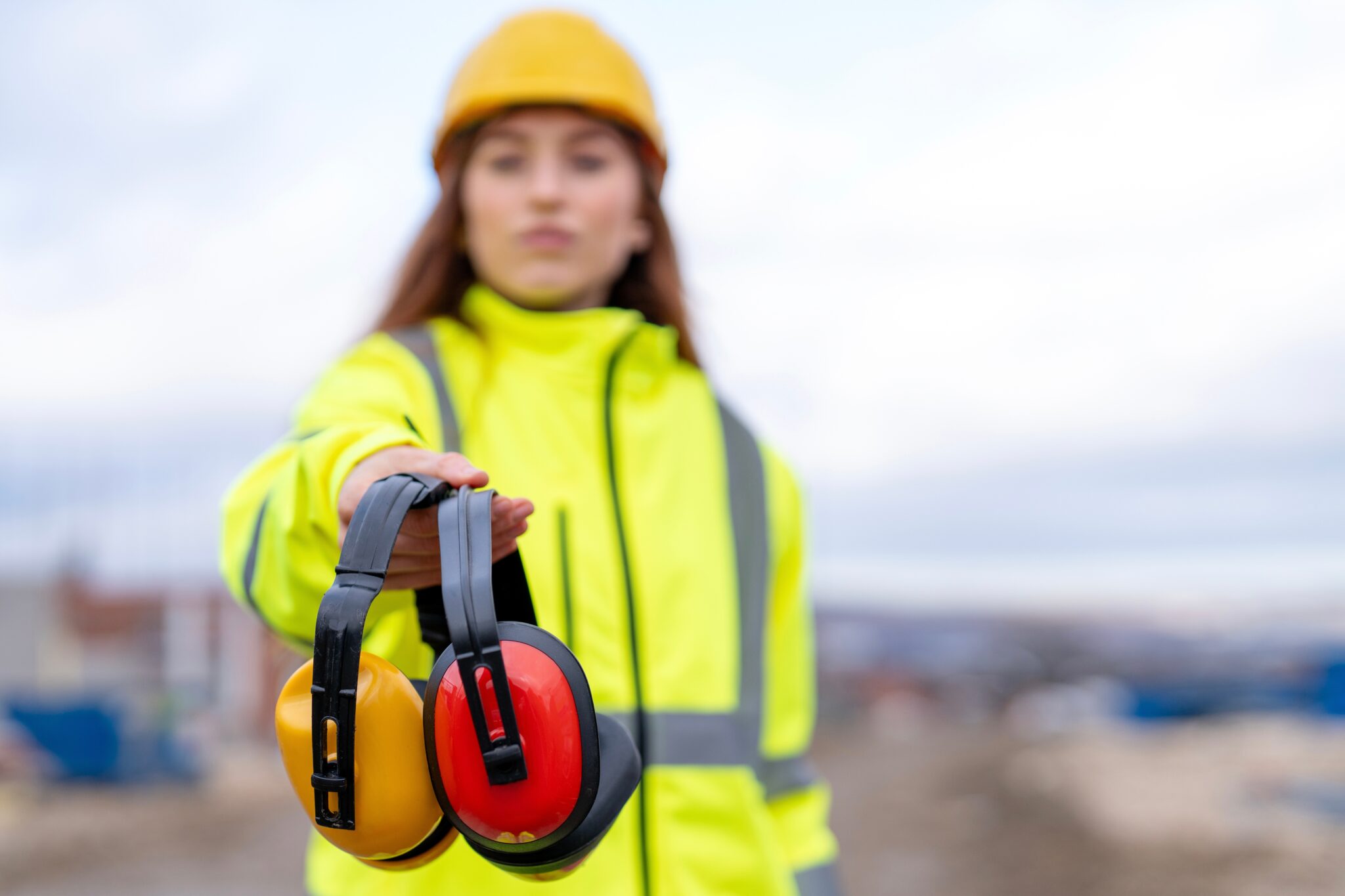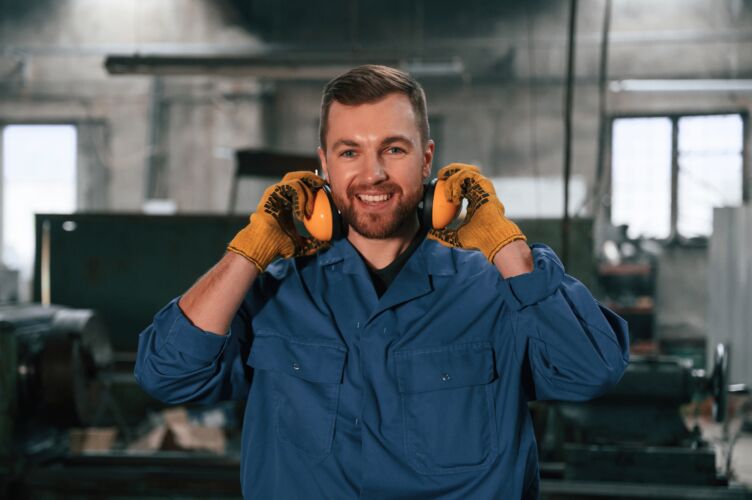In this article
Noise may seem like a routine part of many workplaces. But exposure to high levels of sound can have serious and lasting consequences. Every year, thousands of workers in the UK suffer from hearing loss, tinnitus or other ear-related conditions as a result of preventable noise exposure. In fact, according to the Health and Safety Executive (HSE), an estimated 12,000 workers had work-related hearing problems in the period between 2021/22 to 2023/24.
Additionally, 100 new cases of occupational deafness were recorded in in 2023. Once damaged, hearing cannot be restored, making effective hearing protection not just a recommendation but a necessity.
From busy construction sites and manufacturing plants to music venues and airport runways, hazardous noise levels are present in a wide variety of environments. Despite increased awareness, noise-induced hearing loss (NIHL) remains one of the most common occupational health risks. What’s more, the effects of hearing damage often accumulate gradually, going unnoticed until permanent harm has already been done.
This comprehensive hearing protection in the workplace guide explains everything employers and employees need to know about hearing protection in the workplace. It explores the types of hearing protection available, the relevant legal requirements, how to calculate noise exposure levels, and how to ensure that ear protection is used effectively. Whether you’re responsible for health and safety or simply looking to protect yourself in a noisy job, this guide is a vital resource.
This Hearing Protection Workplace Guide aims to provide essential information on safeguarding workers and ensuring compliance with health and safety regulations.
What is Workplace Hearing Protection?
Workplace hearing protection refers to any equipment or strategy used to safeguard employees from exposure to hazardous levels of noise during their work. It is a crucial part of health and safety measures in environments where noise can reach levels that pose a risk to hearing.
Why Hearing Protection Matters
The human ear is a sensitive and delicate organ. Exposure to noise levels above 85 decibels (dB) over time can cause irreversible damage, especially when workers are exposed for prolonged periods without protection. Conditions like noise-induced hearing loss (NIHL) and tinnitus (a persistent ringing or buzzing in the ears) are not just uncomfortable, they can severely impact quality of life and the ability to work safely and effectively.
Unlike some physical injuries, hearing damage often develops slowly. An individual may not notice the gradual loss of hearing until it becomes significant. This makes proactive protection essential, not optional.
Common Sources of Hazardous Workplace Noise
Noise hazards are not exclusive to heavy industry. Some common sources include:
- Construction equipment – Jackhammers, drills, excavators.
- Manufacturing machinery – Stamping presses, conveyor belts, power tools.
- Transportation and logistics – Aircraft engines, lorry bays, forklifts.
- Entertainment venues – Speakers, live performances, recording equipment.
- Agricultural settings – tractors, harvesters, chainsaws.
Even in office-based environments, occasional high-decibel tools or tasks (such as fire alarm testing or building maintenance) can pose risks if precautions are not taken.
Hearing Protection vs. Noise Control
While hearing protection (like earplugs or ear defenders) is vital, it should be seen as a last line of defence. The preferred approach is to control noise at its source, for example by:
- Substituting noisy equipment with quieter alternatives.
- Installing acoustic barriers or sound-dampening materials.
- Redesigning workflows to reduce exposure times.
When such controls are not sufficient or feasible, personal hearing protection becomes essential.
Types of Ear Protection
There is no one-size-fits-all solution when it comes to hearing protection. The most effective type depends on the noise levels present, the nature of the work being performed, and individual comfort and preference. Here are the main types of ear protection in the workplace:
Earplugs
Earplugs are small inserts that fit directly into the ear canal. They are among the most common and versatile forms of hearing protection.
- Disposable earplugs: Typically made from foam, these expand to fit the ear canal and are designed for single use. They are inexpensive and ideal for intermittent or short-term tasks.
- Reusable earplugs: Made from silicone or rubber, these are more durable and can be washed and reused. They are suited to workers who need ear protection regularly.
- Custom-moulded earplugs: Individually shaped to fit the user’s ear, these offer superior comfort and protection, especially for long-term use or in high-noise environments.
Advantages:
- Lightweight and discreet.
- Easy to carry and store.
- Compatible with other PPE like helmets or goggles.
Disadvantages:
- Can be inserted incorrectly, reducing effectiveness.
- Requires clean hands to avoid ear infections.
- May not provide sufficient protection on their own in extremely noisy settings.
Ear Defenders
Ear defenders (sometimes known as earmuffs) consist of cushioned ear cups that fully cover the ears in place by an adjustable headband.
- Standard ear defenders: Provide consistent protection and are quick to put on and remove.
- Electronic ear defenders: Some models allow for ambient sound of communication through microphones, useful in environments where verbal communication is essential.
Advantages:
- Easier to fit correctly than earplugs.
- Suitable for colder environments (provide warmth as well).
- Often more durable and longer lasting.
Disadvantages:
- Heavier and bulkier than earplugs.
- Can be uncomfortable in hot conditions.
- May interfere with helmets or other headgear.
Canal Caps
Canal caps, or semi-insert earplugs, consist of soft pads or tips held over the ear canal openings by a flexible band.
Often used for tasks where protection needs to be frequently removed and replaced.
Less intrusive than in-ear plugs but typically offer lower protection levels.
Advantages:
- Quick to insert and remove.
- Convenient for short or intermittent exposure.
- Easy to hang around the neck when not in use.
Disadvantages:
- Less protection that fully inserted earplugs or ear defenders.
- May not stay in place during physical activity.
Choosing the Right Hearing Protection
When selecting ear protection, consider the following factors:
- Noise levels: Match the product’s attenuation (SNR) rating to the work environment.
- Compatibility: Ensure the protection works with other PPE.
- Comfort and fit: Especially important for long shifts.
- Ease of use and maintenance: Some environments demand easy-to-clear or replaceable gear.
Providing workers with a choice, and the opportunity to try different types, often improves compliance and effectiveness.

This Hearing Protection Workplace Guide emphasises the importance of using hearing protection effectively to avoid long-term damage.
Hearing protection in the workplace is governed by strict safety standards and legal requirements in the UK. These standards help ensure that the equipment provided is suitable, effective and properly used to reduce the risk of hearing damage.
The Control of Noise at Work Regulations 2005
The primary piece of legislation governing noise exposure is the Control of Noise at Work Regulations 2005, which applies to all workplaces in Great Britain. These regulations require employers to:
- Assess the risks to employees from noise at work.
- Take action to reduce noise exposure that produces risks to hearing health.
- Provide hearing protection where needed.
- Ensure legal limits on noise exposure are not exceeded.
- Provide information, instruction and training.
- Carry out health surveillance where there is a risk to health.
The regulations define two important action levels:
- Lower Exposure Action Value: 80 dB(A) daily or weekly average. Employers must assess risks, provide information, and make hearing protection available.
- Upper Exposure Action Value: 85 dB(A) daily or weekly average. Employers must take steps to reduce noise and ensure hearing protection is worn.
Upper Exposure Action Value: 85 dB(A) daily or weekly average. Employers must take steps to reduce noise and ensure hearing protection is worn.
Personal Protective Equipment (PPE) at Work Regulations 1992 (as amended)
These regulations outline employers’ duties when providing personal protective equipment such as ear defenders or earplugs. Key obligations include:
- Ensuring PPE is suitable for the risk and the wearer.
- Providing it free of charge.
- Maintaining and replacing it as needed.
- Training employees on correct use.
British and European Standards
In the Uk, hearing protection must conform to European and British standards. Look for CE or UKCA marking and compliance with relevant EN 352 standards, which cover various types of hearing protection:
- EN 352-1: Ear defenders (headband style).
- EN 352-2: Ear plugs (reusable and disposable).
- EN 352-3: Ear defenders attached to industrial safety helmets.
- EN 352-4/5: Level-dependent and active noise reduction protectors.
- EN 352-6: Hearing protection with communication systems.
These standards specify performance requirements such as durability, comfort and acoustic attenuation.
SNR and HML Ratings
To understand how much noise a hearing protector can block, check the Single Number Rating (SNR). This is a simplified way to describe the average level of protection in decibels (dB). For example, an SNR of 30 means the device can reduce noise exposure by approximately 30 dB.
In addition, many hearing protectors display HML values – high (H), medium (M) and low (L) frequency attenuation ratings. This allows employers to choose protection suite to the specific noise profile in their workplace.
Ensuring Hearing Protection Works
Providing hearing protection is only effective if it is properly selected, fitted, worn and maintained. Many cases of workplace hearing loss occur not because hearing protection was not available, but because it was not correctly used or it did not provide the level of protection needed.
Correct Fit and Comfort
For hearing protection to work, it must fit the user properly. A poor fit, whether it’s ear defenders that don’t seal properly around the ears or earplugs that are not inserted fully, can significantly reduce the level of protection.
- Ear defenders must form a tight seal around the ears. Hair, glasses and headgear can interfere with this, so it is important to ensure compatibility with other PPE.
- Earplugs must be inserted deep enough to block the ear canal. Foam ear plugs need to be rolled down, inserted, and held in place until they expand. Reusable plugs must match the shape of the ear canal.
Training and Awareness
Employees are far more likely to use hearing protection correctly when they understand why it matters. Training should include:
- The health risks of noise exposure.
- How and when to wear hearing protection.
- How to fit, clean and store it properly.
- How to spot signs of damage or wear.
It’s also important that employees know when hearing protection is mandatory and that there is a clear policy in place for its use.
Maintenance and Replacement
Over time, hearing protection can degrade:
- Ear defenders may lose their cushioning or have cracked seals, reducing effectiveness.
- Reusable earplugs can become misshapen or unhygienic.
- Disposal plugs must be replaced after every use.
A regular maintenance and inspection routine is essential. Employers should:
- Replace damaged or worn-out protection immediately.
- Keep spare stock available.
- Encourage workers to report issues with fit or performance.
Comfort and Compliance
If hearing protection is uncomfortable, too hot or difficult to use, workers are less likely to wear it consistently. Providing different styles or models can help accommodate personal preferences and increase compliance.
Also, consider the work environment. For example:
- In hot conditions, lightweight earplugs might be preferable to ear defenders.
- In intermittent noise situations, canal caps or defenders that can be easily removed and replaced may be more suitable.
- In environments requiring communication, level-dependent or electronic defenders may improve both safety ad usability.
Ultimately, the goal is to make hearing protection a practical and integrated part of everyday working life, not a nuisance to be avoided.
Calculating the Level of Noise Exposure
Understanding how much noise workers are exposed to is essential to determining whether hearing protection is needed and what type is appropriate. Employers are legally required to assess and manage risks from noise under the Control of Noise at Work Regulations 2005, and this starts with calculating exposure levels.
Daily and Weekly Noise Exposure
Noise exposure is typically measured using the A-weighted decibel scale (dB(A)), which reflects how the human ear perceives sound.
The two main exposure metrics are:
- LEP,d (daily personal noise exposure) – the average level of noise a person is exposed to during a standard 8-hour working day.
- LEP,w (weekly personal noise exposure) – used when noise exposure varies significantly over the course of a week.
If workers are exposed to noise above 80 dB(A) over the course of a day or week, the employer must take action.
Common Noise Levels in Everyday and Workplace Settings
So that we can best understand these levels, let’s take a look at some examples:
| Sound Source | Approximate Decibel Level in dB(A) | Risk of Hearing Damage |
| Normal conversation | 60-65 dB | Safe |
| Busy office environment | 70 dB | Low risk, but may affect concentration |
| Vacuum cleaner (close by) | 75-80 dB | Just below action level |
| Heavy traffic at close range | 85 dB | Threshold for mandatory hearing protection |
| Petrol-powered lawn mower | 90 dB | Risk over long exposure |
| Forklift truck or busy warehouse | 90-95 dB | Hearing protection likely needed |
| Angle grinder or circular saw | 100-110 dB | Short exposure can cause damage |
| Live music venue or nightclub | 100-120 dB | Dangerous without protection |
| Standard fire alarm | 110-120 dB | Potentially harmful within seconds |
| Chainsaw | 115-120 dB | Serious risk. Protection essential |
| Ambulance or police siren (close) | 120-125 dB | Pain threshold. Can cause immediate harm. |
| Jet engine at take-off (25 m away) | 130-140 dB | Extreme danger to hearing. |
| Gunshot or explosion | 140-160dB | Immediate damage likely |
Peak Sound Pressure Levels
In addition to average noise exposure, peak sound pressure levels (measured in C-weighted decibels, or dB(C)) must also be considered. These represent short bursts of very loud noise, such as hammering, gunshots or impact tools, that can cause immediate damage.
Employers must take action if peak noise reaches:
- 135 dB(C) (Lower Exposure Action Value)
- 137 dB(C) (Upper Exposure Action Value)
- 140 dB(C) (Absolute Exposure Action Value)
How to Measure Workplace Noise
Once noise levels are calculated, employers should:
- Compare results with the legal action values and limits.
- Decide whether engineer controls (like quieter machines or enclosures) can reduce noise.
- Determine whether hearing protection is needed, and what SNR rating is appropriate.
- Identify who is exposed, for how long, and how to minimise risk.
Online Tools and Resources
The Health and Safety Executive (HSE) provides a free noise exposure calculator to help employers determine daily or weekly exposure. This tool allows you to enter:
- Noise levels in dB(A).
- Duration of exposure.
- Number of exposure periods.
It then calculates a daily or weekly noise exposure figure, helping employers assess legal obligations and next steps.

When Should You Wear Ear Protection?
Hearing protection must be worn whenever employees are at risk of exposure to noise that could cause harm. However, it’s not just about throwing on a pair of ear defenders and hoping for the best, it must be strategically deployed, based on the type of noise, the duration of the exposure, and the nature of the work.
Noise Levels that Trigger Action
As mentioned previously, under the Control of Noise at Work Regulations 2005, there are specific thresholds that determine when hearing protection should be provided or worn.
Key Exposure Values
| Lower Exposure Action Value | 80 dB(A) | Point at which employers must provide information and make protection available. |
| Upper Exposure Action Value | 85 dB(A) | Point at which employers must take action to reduce exposure and enforce protection. |
| Exposure Limit Value | 87 dB(A)* | Maximum permitted exposure, taking into account hearing protection. |
| Peak Sound Pressure Level | 135-140 dB(C) | Limits for sudden, impulsive noise (e.g. hammering, explosions). |
Peak Sound Levels
Even if average noise exposure seems acceptable, sudden impulse or impact noises (e.g. from hammers, firearms or punch presses) that exceed 137 dB(C) may also require immediate use of hearing protection, especially in sectors like:
- Construction
- Manufacturing
- Metalwork and fabrication
- Agriculture
- Engineering
Practical Situations Where Hearing Protection is Required
Some examples where is hearing protection is typically required include:
- Using power tools (e.g. grinders, drills, saws).
- Operating heavy machinery.
- Working in noisy production or assembly lines.
- Demolition and roadworks.
- Environments with frequent alarms or sirens.
- Airport ground operations.
Even if less obvious settings, such as certain hospitality venues, education workshops or live music events, exposure can sometimes exceed safe limits.
Duration Matters
It’s not just the intensity of the noise but also the length of exposure that poses a risk. For example, exposure to 85 dB(A) for 8 hours can be just as damaging as exposures to 88 dB(A) for 4 hours. Employers must consider both intensity and duration when determining the need for hearing protection.
Vulnerable Workers
Some workers may be at higher risk, including:
- Those already experiencing hearing loss.
- Workers with medical conditions affecting hearing.
- Young workers, who may be more susceptible to long-term damage.
Extra precautions may be needed in these cases, including lower trigger points for protection or regular hearing checks.
Hearing Protection Zones
If areas of the workplace exceed the upper exposure action value, these must be designated as Hearing Protection Zones, with:
- Clearly visible safety signage
- Strict enforcement of hearing protection rules
- Regular monitoring of noise levels.
This helps create a culture where protection is taken seriously and reduces the risk of long-term harm.
What the Law Requires Employers to Do
The law is clear: employers have a legal duty to prevent or reduce risks to employees’ hearing from exposure to excessive noise. As mentioned, in the UK, this duty is set out under the Control of Noise at Work Regulations 2005.
Employers must:
Assess the Risk
- Identify noise hazards in the workplace.
- Determine which workers are exposed and for how long.
- Calculate noise exposure levels using sound measurements or dosimetry.
- Consider both the average daily/weekly noise (dB(A)) and peak noise level (dB(C)).
Take Action at Legal Thresholds
- At 80 dB(A):
- Provide workers with information and training.
- Make suitable hearing protection available.
- At 85 dB(A):
- Implement a formal noise control plan.
- Enforce the use of hearing protection.
- Designate and signpost Hearing Protection Zones.
- Exposure must never exceed 87 dB(A) when hearing protection is factored in.
Reduce Noise Exposure Where Possible
The regulations follow the principle of hierarchy of control. Employers should always:
- Try to eliminate the noise hazard at its source.
- Use engineering solutions (e.g. quieter equipment, enclosures).
- Redesign workflows to reduce exposure time or keep workers at a distance.
- Use hearing protection only when other methods are insufficient.
Provide Information and Training
Workers must be informed about:
- The health risks of noise exposure.
- What their exposure levels ar.
- How to use and care for hearing protection correctly.
- The meaning of noise signage and Hearing Protection Zones.
This training should be:
- Easy to understand.
- Regularly refreshed.
- Adapted for new starters or young/inexperienced workers.
Provide Suitable Hearing Protection
Hearing protection must:
- Be appropriate to the level of risk.
- Comply with relevant safety standards.
- Be maintained and replaced as needed.
Workers must be involving in selecting hearing protection where possible, and encouraged to report any issues with fit, comfort or wearability.
Carry Out Health Surveillance
If workers are regularly exposed at or above the upper action value of 85 dB(A), the employer must offer:
- Baseline audiometry (hearing test) when exposure begins.
- Regular follow-up testing (usually annually for the first two years, then every three years).
- Monitoring of hearing loss trends.
This surveillance helps identify early signs of noise-induced hearing damage so that further action can be taken.
How Hearing Protection Can Be Used Effectively
Even the best hearing protection is useless if it’s not worn correctly, doesn’t fit properly or is used inconsistently. For hearing protection to reduce the risk of noise-induced hearing loss, it must be used effectively and consistently.
Choose the Right Type of Protection
Not all hearing protection is equal. The best option depends on:
- The level and type of noise (steady, intermittent or impulsive).
- The working environment (e.g. hot, dusty, confined).
- The worker’s needs (comfort, ability to communicate, compatibility with other PPE).
If the protection is too heavy-duty, it can overprotect, leading to communication difficulties, isolation and even safety risks. If it is too light, it won’t reduce noise to safe levels.
Top Tip: Match the protection’s Single Number Rating (SNR) to the level of noise exposure, ensuring the final exposure is between 70-80 dB(A) at the ear.
Ensure Proper Fit and Comfort
Proper fit is one of the most common reasons hearing protection fails. To be effective:
- Earplugs must fully seal the ear canal. Pre-moulded plugs need the correct size, foam plugs must be rolled and inserted properly.
- Ear defenders must form a tight seal around the ear. Hair, glasses or hats can break the seal and reduce protection.
- Custom-moulded protectors offer a tailored fir and can be especially used in industries requiring frequent communication.
Training in correct fitting is essential. A good fit should feel secure but not painful.
Wear It Consistently in Noisy Areas
Even short bursts of unprotected exposure can cause permanent hearing damage. Hearing protection should be:
- Put on before entering a noisy area.
- Worn continuously in areas where noise exceeds safe limits.
- Not removed until back in a safe environment.
Inconsistent use greatly reduces effectiveness. For example, removing hearing protection for just five minutes in an eight-hour shift can significantly reduce its overall benefit.
Maintain and Replace When Needed
Hearing protection is subject to wear and tear:
- Foam earplugs are usually single-use and should not be reused.
- Reusable earplugs must be cleaned regularly and replaced if worn out.
- Ear defenders should have cushions checked and replaced when hardened, cracked or flattened.
Dirty, damaged or worn-out protection won’t work properly, and may even cause irritation or infection.
Encourage User Engagement
Involving workers in selecting and trialling hearing protection can lead to:
- Better fit
- Greater comfort
- Increased compliance
It also shows a positive safety culture where workers feel valued and listened to.
Supervise and Reinforce
Line managers and supervisors play a key role in reinforcing consistent use. Employers should:
- Provide visible reminders (e.g. signs, floor markings).
- Include hearing protection checks in routine safety inspections.
- Challenge and correct unsafe practices.
Regular toolbox talks and safety briefings can help reinforce the importance of proper use.

Summary
Noise-induced hearing loss is a serious but entirely preventable occupational health issue. By understanding the risks, legal responsibilities and the range of hearing protection options available, employers can take meaningful steps to safeguard their workers’ long-term hearing.
In this guide, we’ve explored:
- What workplace hearing protection is and why it matters.
- The types of ear protection available and how to choose the right one.
- The UK safety standards and regulations that govern hearing protection.
- How to ensure protection is used effectively and consistently.
- When ear protection should be worn and when it must be.
Protecting hearing isn’t just about meeting legal obligations, it’s about creating a safer, more supportive working environment where employees are not putting their health at risk. By making hearing protection a core part of workplace safety culture, workplaces not only reduce the risk of lifelong hearing damage but also demonstrate a commitment to employee wellbeing and regulatory compliance.






